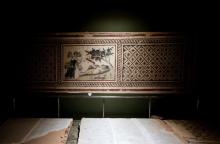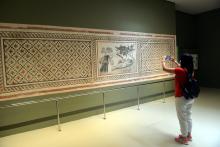Hatay Archaeology Museum
Quake-hit Hatay Archaeology Museum gets reinforced
The strengthening works are ongoing uninterruptedly in Türkiye's prominent Hatay Archaeology Museum, which sustained damage during the deadly earthquakes that jolted the country's southeast in early February last year.
- Read more about Quake-hit Hatay Archaeology Museum gets reinforced
- Log in to post comments
UN organizes donation campaign for cultural heritage in quake-zone
The United Nations Development Program (UNDP) has launched a global donation campaign for the restoration of cultural assets damaged in the Feb. 6 earthquakes.
With a total of 352 out of 8,444 historic buildings in 11 provinces in the earthquake zone damaged or destroyed, the UNDP campaign focuses on buildings such as Hatay Archaeology Museum, Gaziantep Castle and Sarımiye Mosque.
Hatay’s artifacts moved to Kırşehir Museum
Nearly 400 small artifacts in the Hatay Archaeology Museum, some of which got damaged during the Kahramanmaraş-centered earthquakes in February, were sent to the Kırşehir Museum for protection against aftershocks.
Approximately 150 artifacts, weighing tons, are also preserved in their own places in the museum with a method of on-site preservation.
- Read more about Hatay’s artifacts moved to Kırşehir Museum
- Log in to post comments
Restoration to start at quake-hit assets
Culture and Tourism Minister Mehmet Nuri Ersoy met on March 14 with industry representatives in the tent set up at the Hatay Archaeology Museum in the quake-hit province of Hatay.
Ersoy said that they had started to carry out the decisions made within the scope of the Hatay Cultural Heritage Survival Project.
- Read more about Restoration to start at quake-hit assets
- Log in to post comments
Turkish province Hatay’s mosaics on display abroad
Some 200 mosaics unearthed in the southern province of Hatay during archaeological excavations conducted by a commission set up before 1939, the year when the city joined the Turkish Republic, are exhibited abroad, as the artifacts found were shared among the commission members, says Hatice Pamir from Mustafa Kemal University's Archaeology Department.
- Read more about Turkish province Hatay’s mosaics on display abroad
- Log in to post comments
Anatolia’s largest olive oil factory unearthed
A Roman-era olive oil factory has been unearthed during excavations in the İskenderun district of Hatay. It has been reported that the structure, which turned out to be the largest olive oil factory in Anatolia, will be turned into a museum.
- Read more about Anatolia’s largest olive oil factory unearthed
- Log in to post comments
‘Vineyard Mosaic’ ready to be showcased
An ancient mosaic that was unearthed during excavations in the southern province of Hatay will be on display in November to visitors of the Hatay Archeological Museum, the head of the museum said Oct. 21.
- Read more about ‘Vineyard Mosaic’ ready to be showcased
- Log in to post comments
Oldest mosaic unearthed in central Turkey
Excavations that have been ongoing in the Central Anatolian province of Yozgat have unearthed a 3,500-year-old mosaic, believed to be the oldest in the world.
- Read more about Oldest mosaic unearthed in central Turkey
- Log in to post comments
Local tourists rush to Hatay Archaeology Museum
The Archeology Museum, where 3,500 square meters of mosaics are exhibited in the southern province of Hatay's Antakya district, has become a popular place for local tourists. The museum, which is home to the world's largest mosaic display area, includes a statue of the Hittite King Suppiluliuma II, dating back 3,000 years, as well as many architectural finds.
- Read more about Local tourists rush to Hatay Archaeology Museum
- Log in to post comments
Hotel-museum presents artifacts from 5 periods
The Necmi Asfuroğlu Archaeology Museum, which has the museum-hotel concept and displays artifacts belonging to five different periods, has welcomed 22,500 visitors since its opening last year.
- Read more about Hotel-museum presents artifacts from 5 periods
- Log in to post comments










